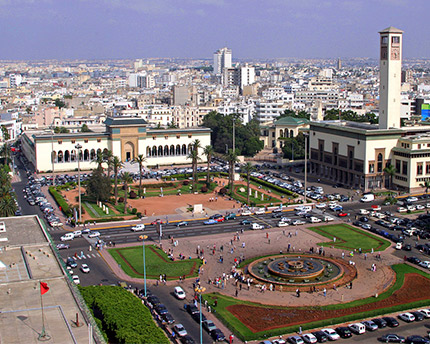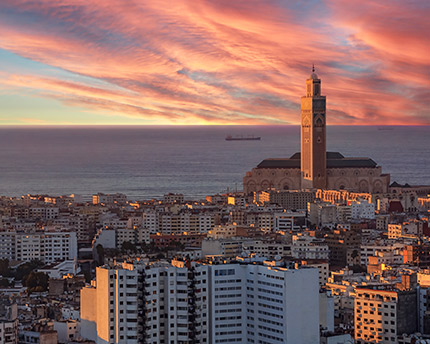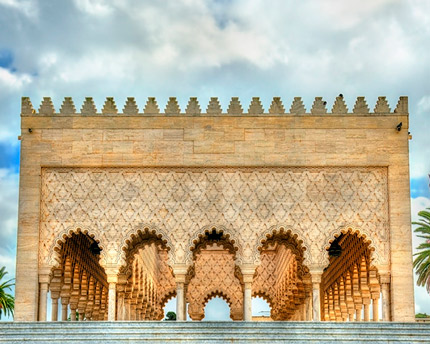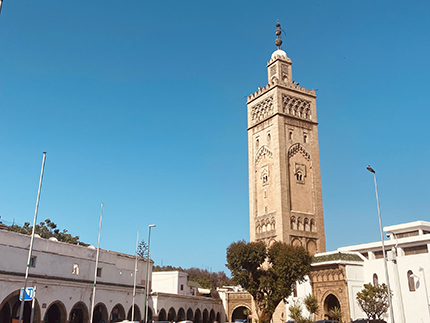Casablanca is a unique blend of what could well be a modern French city and an ancient north African medina; it’s an eclectic, diverse place, where nuances of various cultural origins and the very identity of contemporary Morocco meet. A clear example of this is Mohammed V Square.
Designed at the beginning of the 20th century to become the heart of the “European City” envisaged by the French Protectorate, this large square flanked by splendid period buildings is today the administrative heart of Casablanca and is considered by many to be the central point of the city.
History of Mohammed V Square
In 1916, the French Protectorate was fully established over a large part of Moroccan territory and the Resident-General (French governor) Louis Hubert Lyautey and the architects Henri Prost and Joseph Marrast launched a major urban development plan that would transform the face of the more traditional Casablanca into a new “European-style” city.
In this regard, the undisputed heart of the new project, which opened up to the south of the old medina, was to be a large square, said to be inspired by the Place Stanislas in the French city of Nancy, the birthplace of Marshal Lyautey himself, flanked by important buildings of the colonial public administration.
As a result, during the 1920s and 1930s, the complex gained its final appearance, marked by a unique combination of tradition and modernity, embodied in façades, arcades, and other structures influenced by both Hispano-Muslim and Art Deco architecture. In any case, the square originally known as Grande Place, Place de France, or Place de la Victoire eventually became the Place de Mohammed V and, more precisely, the heart of the “White City”.
An architectural gem: what to see in Mohammed V Square
Also known as the Place des Pigeons, this large urban space is flanked by a collection of buildings that mix Art Deco elements with Hispano-Muslim, Andalusian, and neo-Moorish influences, and which house some of the city’s most important institutions, such as the Prefecture, inaugurated in 1930 by the then Sultan Mohammed V, which is one of his most striking buildings. The Post Office, the Central Bank of Morocco, the Palace of Justice, the Regional Government Delegation (Wilaya de Casablanca-Settat), and the French Consulate General also form part of the square, among other historic buildings.
The large circular fountain in front of the Palace of Justice, in the centre of the square, is another of its distinctive features and occasionally provides a wonderful show with jets of water and music. In addition, following the extensive renovation of the square in 2020, a new modern version of the same fountain was installed on the west side of the esplanade, just across Boulevard Hassan II.
What’s more, at the western end of the square the modern Grand Theatre of Casablanca has already become the area’s new icon. Designed by the French architect Christian de Portzamparc, winner of the Pritzker Architecture Prize in 1994, in collaboration with the Moroccan architect Rachid Andaloussi, the building is made up of several pavilions reminiscent of an ancient medina. With everything ready for its opening, expected by the end of 2022, the spectacular theatre will undoubtedly be the focal point for performing arts in the city, and one of the most important artistic and cultural spaces in Africa.
What to see near the square
Nestled in the heart of the city, this large urban space is also an excellent starting point for exploring the area, and there are all sorts of attractions nearby:
- Arab League Park – An oasis of peace in the heart of bustling Casablanca. This is one way to define this large green lung of almost 30 hectares (the largest park in the city), populated by different species of trees and plants, and made up of large grassy areas, sports areas, playgrounds, cafés, and crossed by a long, narrow fountain, like a small canal flanked by palm trees, which runs from one end to the other. In any case, it’s a very welcoming place, frequented by the city’s own inhabitants, recently renovated and ideal for a stroll and to relax in the shade of the vegetation.
- Former Cathedral of the Sacred Heart – Within the huge Arab League Park, very close to the southern side of Mohammed V Square, also stands this large building with a neo-Gothic style and Art Deco and Andalusian overtones, built in the first half of the 20th century. It was a Catholic church during the years of the French Protectorate (that was never really a cathedral), and was deconsecrated and converted into a cultural centre after Moroccan independence in 1956. In addition to its undeniable architectural value, it regularly hosts various types of exhibitions and cultural events.
- Abderrahman Slaoui Foundation Museum – Since it opened its doors in 2012, this museum, which displays the private collection of Moroccan businessman and collector Abderrahman Slaoui (Fez, 1919 – Casablanca, 2001), has become a key part of the city’s artistic and cultural offerings. Delicate traditional objects, modern and contemporary art, pieces by Moroccan master jewellers, posters and graphic arts, and an extraordinary “cabinet of curiosities” give substance and shape to this interesting museum’s unique collection. In addition to the permanent collection, its programme of temporary exhibitions, as well as the various artistic workshops that are regularly held, make this museum a very interesting place to visit.
- United Nations Square – Four streets to the north of the square, just before crossing the walls of the old medina, is another esplanade, an iconic space in the city’s history that has undergone changes in its appearance on several occasions. Extensively renovated a decade or so ago, it’s now a busy meeting place in the heart of Casablanca, a connecting road between the old and modern city, and an important stop on the modern local tram network. The famous mid-20th century BMCI building and the reproduction of the old clock tower are just two of the icons of the square, and therefore of the city.
Where to stay in Casablanca
Less than a 15-minute walk from Mohammed V Square are two of the best places to stay in the “White City”: the Barceló Casablanca hotel and the Barceló Anfa Casablanca hotel .
The former is a modern four-star hotel that seamlessly combines the best of Morocco with the most modern equipment; a perfect place to discover the city and to enjoy the best local gastronomy. As for the Barceló Anfa Casablanca, its 206 fully equipped rooms, its modern spa and gym, and its unique culinary offer, which combines local products with new gastronomic trends, make it an exceptional place to enjoy a few days in Casablanca. And all this with an Art Deco design that makes this hotel even more special.




































































